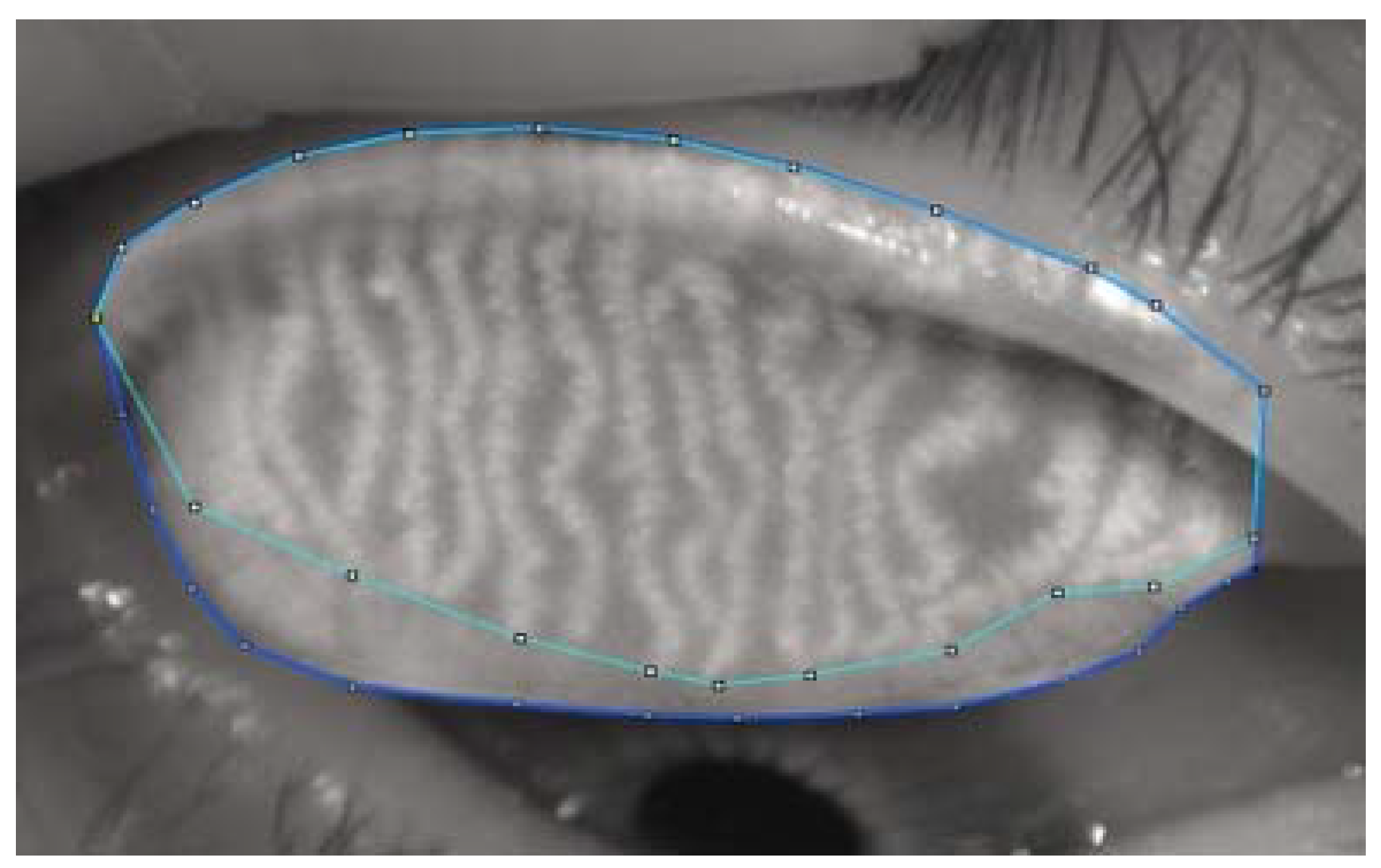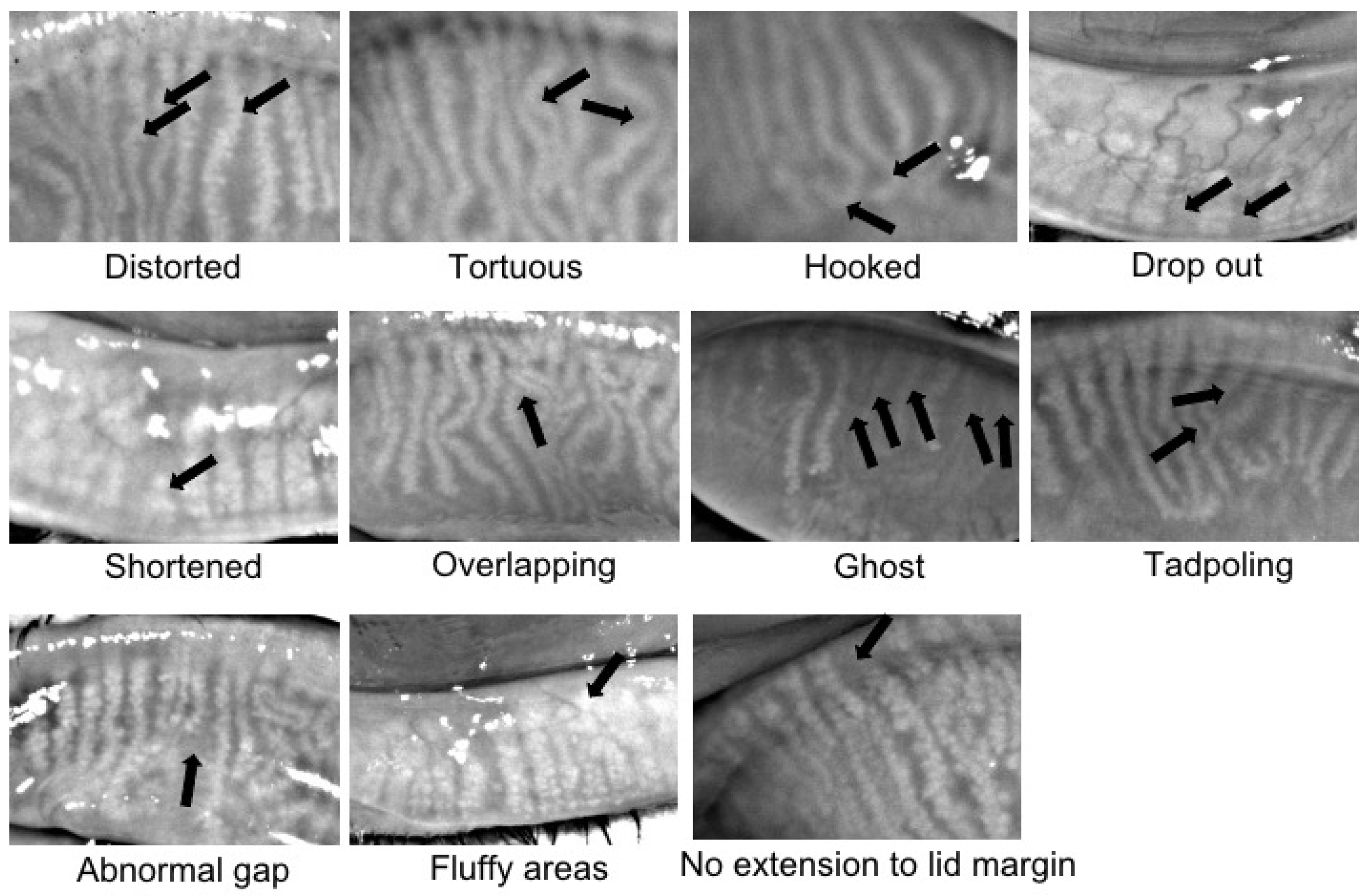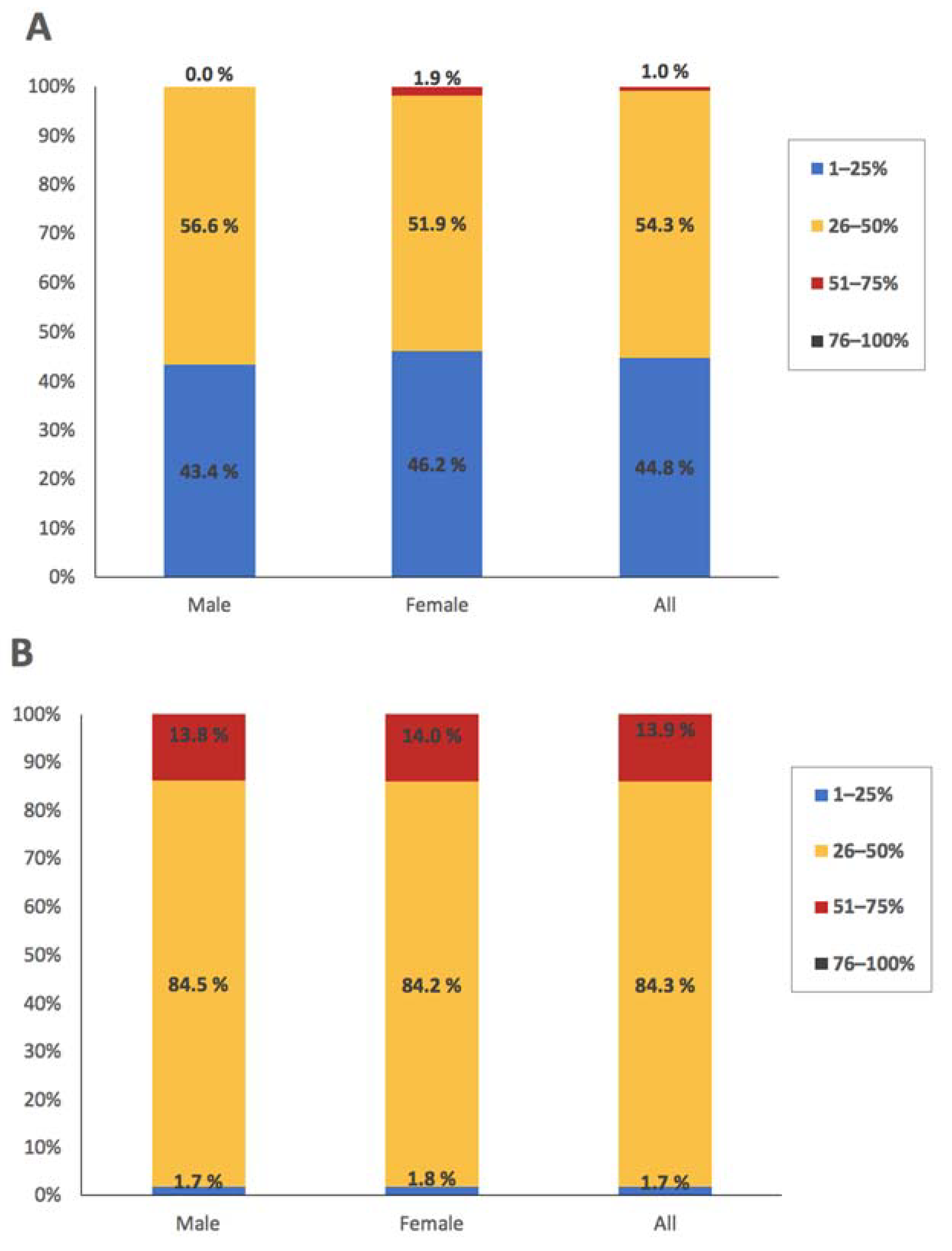Morphology of Meibomian Glands in a 65-Year-Old Norwegian Population without Dry Eye Disease
Abstract
:1. Introduction
2. Methods
3. Results
3.1. Study Subjects’ Clinical Characteristics
3.2. Meibomian Gland Morphological Features
3.3. Correlations between Meibomian Gland Morphology and Other Dry Eye Tests
3.4. Meibomian Gland Dropout Risk Factors
4. Discussion
Supplementary Materials
Author Contributions
Funding
Institutional Review Board Statement
Informed Consent Statement
Data Availability Statement
Acknowledgments
Conflicts of Interest
References
- Blackie, C.A.; Korb, D.R.; Knop, E.; Bedi, R.; Knop, N.; Holland, E.J. Nonobvious obstructive meibomian gland dysfunction. Cornea 2010, 29, 1333–1345. [Google Scholar] [CrossRef] [Green Version]
- Nelson, J.D.; Shimazaki, J.; Benitez-del-Castillo, J.M.; Craig, J.P.; McCulley, J.P.; Den, S.; Foulks, G.N. The international workshop on meibomian gland dysfunction: Report of the definition and classification subcommittee. Investig. Ophthalmol. Vis. Sci. 2011, 52, 1930–1937. [Google Scholar] [CrossRef] [Green Version]
- Schaumberg, D.A.; Nichols, J.J.; Papas, E.B.; Tong, L.; Uchino, M.; Nichols, K.K. The international workshop on meibomian gland dysfunction: Report of the subcommittee on the epidemiology of, and associated risk factors for, MGD. Investig. Ophthalmol. Vis. Sci. 2011, 52, 1994–2005. [Google Scholar] [CrossRef] [Green Version]
- Nichols, K.K.; Foulks, G.N.; Bron, A.J.; Glasgow, B.J.; Dogru, M.; Tsubota, K.; Lemp, M.A.; Sullivan, D.A. The international workshop on meibomian gland dysfunction: Executive summary. Investig. Ophthalmol. Vis. Sci. 2011, 52, 1922–1929. [Google Scholar] [CrossRef] [PubMed] [Green Version]
- Arita, R.; Itoh, K.; Maeda, S.; Maeda, K.; Furuta, A.; Fukuoka, S.; Tomidokoro, A.; Amano, S. Proposed diagnostic criteria for obstructive meibomian gland dysfunction. Ophthalmology 2009, 116, 2058–2063.e1. [Google Scholar] [CrossRef]
- Ban, Y.; Shimazaki-Den, S.; Tsubota, K.; Shimazaki, J. Morphological evaluation of meibomian glands using noncontact infrared meibography. Ocul. Surf. 2013, 11, 47–53. [Google Scholar] [CrossRef] [PubMed] [Green Version]
- Finis, D.; Ackermann, P.; Pischel, N.; Konig, C.; Hayajneh, J.; Borrelli, M.; Schrader, S.; Geerling, G. Evaluation of Meibomian Gland Dysfunction and Local Distribution of Meibomian Gland Atrophy by Non-contact Infrared Meibography. Curr. Eye Res. 2015, 40, 982–989. [Google Scholar] [CrossRef] [PubMed]
- Arita, R.; Itoh, K.; Inoue, K.; Amano, S. Noncontact infrared meibography to document age-related changes of the meibomian glands in a normal population. Ophthalmology 2008, 115, 911–915. [Google Scholar] [CrossRef] [PubMed]
- Machalinska, A.; Zakrzewska, A.; Safranow, K.; Wiszniewska, B.; Machalinski, B. Risk Factors and Symptoms of Meibomian Gland Loss in a Healthy Population. J. Ophthalmol. 2016, 2016, 7526120. [Google Scholar] [CrossRef] [Green Version]
- Nien, C.J.; Massei, S.; Lin, G.; Nabavi, C.; Tao, J.; Brown, D.J.; Paugh, J.R.; Jester, J.V. Effects of age and dysfunction on human meibomian glands. Arch. Ophthalmol. 2011, 129, 462–469. [Google Scholar] [CrossRef] [PubMed] [Green Version]
- Lin, X.; Wu, Y.; Chen, Y.; Zhao, Y.; Xiang, L.; Dai, Q.; Fu, Y.; Zhao, Y.; Zhao, Y.E. Characterization of Meibomian Gland Atrophy and the Potential Risk Factors for Middle Aged to Elderly Patients With Cataracts. Transl. Vis. Sci. Technol. 2020, 9, 48. [Google Scholar] [CrossRef] [PubMed]
- Diep, M.T.; Jensen, J.L.; Skudutyte-Rysstad, R.; Young, A.; Sodal, A.T.T.; Petrovski, B.E.; Hove, L.H. Xerostomia and hyposalivation among a 65-yr-old population living in Oslo, Norway. Eur. J. Oral Sci. 2021, 129, e12757. [Google Scholar] [CrossRef]
- Daniel, E.; Maguire, M.G.; Pistilli, M.; Bunya, V.Y.; Massaro-Giordano, G.M.; Smith, E.; Kadakia, P.A.; Asbell, P.A.; Dry Eye, A.; Management Study Research, G. Grading and baseline characteristics of meibomian glands in meibography images and their clinical associations in the Dry Eye Assessment and Management (DREAM) study. Ocul. Surf. 2019, 17, 491–501. [Google Scholar] [CrossRef]
- Wolffsohn, J.S.; Arita, R.; Chalmers, R.; Djalilian, A.; Dogru, M.; Dumbleton, K.; Gupta, P.K.; Karpecki, P.; Lazreg, S.; Pult, H.; et al. TFOS DEWS II Diagnostic Methodology report. Ocul. Surf. 2017, 15, 539–574. [Google Scholar] [CrossRef] [PubMed]
- Yin, Y.; Gong, L. Reversibility of Gland Dropout and Significance of Eyelid Hygiene Treatment in Meibomian Gland Dysfunction. Cornea 2017, 36, 332–337. [Google Scholar] [CrossRef]
- Yin, Y.; Liu, N.; Gong, L.; Song, N. Changes in the Meibomian Gland After Exposure to Intense Pulsed Light in Meibomian Gland Dysfunction (MGD) Patients. Curr. Eye Res. 2018, 43, 308–313. [Google Scholar] [CrossRef] [Green Version]
- Tomlinson, A.; Bron, A.J.; Korb, D.R.; Amano, S.; Paugh, J.R.; Pearce, E.I.; Yee, R.; Yokoi, N.; Arita, R.; Dogru, M. The international workshop on meibomian gland dysfunction: Report of the diagnosis subcommittee. Investig. Ophthalmol. Vis. Sci. 2011, 52, 2006–2049. [Google Scholar] [CrossRef]
- Pult, H.; Riede-Pult, B.H.; Nichols, J.J. Relation between upper and lower lids’ meibomian gland morphology, tear film, and dry eye. Optom. Vis. Sci. Off. Publ. Am. Acad. Optom. 2012, 89, E310–E315. [Google Scholar] [CrossRef] [PubMed]
- Eom, Y.; Choi, K.E.; Kang, S.Y.; Lee, H.K.; Kim, H.M.; Song, J.S. Comparison of meibomian gland loss and expressed meibum grade between the upper and lower eyelids in patients with obstructive meibomian gland dysfunction. Cornea 2014, 33, 448–452. [Google Scholar] [CrossRef]
- Sahin, A.; Liu, Y.; Kam, W.R.; Darabad, R.R.; Sullivan, D.A. Dihydrotestosterone suppression of proinflammatory gene expression in human meibomian gland epithelial cells. Ocul. Surf. 2020, 18, 199–205. [Google Scholar] [CrossRef]
- Khandelwal, P.; Liu, S.; Sullivan, D.A. Androgen regulation of gene expression in human meibomian gland and conjunctival epithelial cells. Mol. Vis. 2012, 18, 1055–1067. [Google Scholar]
- Wang, L.X.; Deng, Y.P. Androgen and meibomian gland dysfunction: From basic molecular biology to clinical applications. Int. J. Ophthalmol. 2021, 14, 915–922. [Google Scholar] [CrossRef] [PubMed]
- Sullivan, D.A.; Sullivan, B.D.; Ullman, M.D.; Rocha, E.M.; Krenzer, K.L.; Cermak, J.M.; Toda, I.; Doane, M.G.; Evans, J.E.; Wickham, L.A. Androgen influence on the meibomian gland. Investig. Ophthalmol. Vis. Sci. 2000, 41, 3732–3742. [Google Scholar]
- Sullivan, D.A.; Rocha, E.M.; Aragona, P.; Clayton, J.A.; Ding, J.; Golebiowski, B.; Hampel, U.; McDermott, A.M.; Schaumberg, D.A.; Srinivasan, S.; et al. TFOS DEWS II Sex, Gender, and Hormones Report. Ocul. Surf. 2017, 15, 284–333. [Google Scholar] [CrossRef]
- Suzuki, T.; Schirra, F.; Richards, S.M.; Jensen, R.V.; Sullivan, D.A. Estrogen and progesterone control of gene expression in the mouse meibomian gland. Investig. Ophthalmol. Vis. Sci. 2008, 49, 1797–1808. [Google Scholar] [CrossRef] [PubMed]
- Labrie, F.; Belanger, A.; Cusan, L.; Gomez, J.L.; Candas, B. Marked decline in serum concentrations of adrenal C19 sex steroid precursors and conjugated androgen metabolites during aging. J. Clin. Endocrinol. Metab. 1997, 82, 2396–2402. [Google Scholar] [CrossRef]
- Yeotikar, N.S.; Zhu, H.; Markoulli, M.; Nichols, K.K.; Naduvilath, T.; Papas, E.B. Functional and Morphologic Changes of Meibomian Glands in an Asymptomatic Adult Population. Investig. Ophthalmol. Vis. Sci. 2016, 57, 3996–4007. [Google Scholar] [CrossRef] [PubMed] [Green Version]
- Pult, H. Relationships between Meibomian Gland Loss and Age, Sex, and Dry Eye. Eye Contact Lens 2018, 44 (Suppl. 2), S318–S324. [Google Scholar] [CrossRef]
- Shirakawa, R.; Arita, R.; Amano, S. Meibomian gland morphology in Japanese infants, children, and adults observed using a mobile pen-shaped infrared meibography device. Am. J. Ophthalmol. 2013, 155, 1099–1103.e1. [Google Scholar] [CrossRef]
- Brooks, C.C.; Gupta, P.K. Meibomian Gland Morphology among Patients Presenting for Refractive Surgery Evaluation. Clin. Ophthalmol. 2021, 15, 315–321. [Google Scholar] [CrossRef]
- Den, S.; Shimizu, K.; Ikeda, T.; Tsubota, K.; Shimmura, S.; Shimazaki, J. Association between meibomian gland changes and aging, sex, or tear function. Cornea 2006, 25, 651–655. [Google Scholar] [CrossRef] [PubMed]
- Eom, Y.; Lee, J.S.; Kang, S.Y.; Kim, H.M.; Song, J.S. Correlation between quantitative measurements of tear film lipid layer thickness and meibomian gland loss in patients with obstructive meibomian gland dysfunction and normal controls. Am. J. Ophthalmol. 2013, 155, 1104–1110.e2. [Google Scholar] [CrossRef]
- Srinivasan, S.; Menzies, K.; Sorbara, L.; Jones, L. Infrared imaging of meibomian gland structure using a novel keratograph. Optom. Vis. Sci. Off. Publ. Am. Acad. Optom. 2012, 89, 788–794. [Google Scholar] [CrossRef] [PubMed]
- Feng, Y.; Gao, Z.; Feng, K.; Qu, H.; Hong, J. Meibomian gland dropout in patients with dry eye disease in China. Curr. Eye Res. 2014, 39, 965–972. [Google Scholar] [CrossRef]
- Ablamowicz, A.F.; Nichols, J.J.; Nichols, K.K. Association between Serum Levels of Testosterone and Estradiol with Meibomian Gland Assessments in Postmenopausal Women. Investig. Ophthalmol. Vis. Sci. 2016, 57, 295–300. [Google Scholar] [CrossRef]
- Pult, H.; Riede-Pult, B. Comparison of subjective grading and objective assessment in meibography. Contact Lens Anterior Eye 2013, 36, 22–27. [Google Scholar] [CrossRef] [PubMed]
- He, F.; Zhao, Z.; Liu, Y.; Lu, L.; Fu, Y. Assessment of Ocular Surface Damage during the Course of Type 2 Diabetes Mellitus. J. Ophthalmol. 2018, 2018, 1206808. [Google Scholar] [CrossRef]
- Yu, T.; Han, X.G.; Gao, Y.; Song, A.P.; Dang, G.F. Morphological and cytological changes of meibomian glands in patients with type 2 diabetes mellitus. Int. J. Ophthalmol. 2019, 12, 1415–1419. [Google Scholar] [CrossRef] [PubMed]



| All | Male | Female | p-Value * | ||||
|---|---|---|---|---|---|---|---|
| n | % | n | % | n | % | ||
| Ethnicity | 117 | 60 | 57 | 0.062 | |||
| West European | 109 | 93.2 | 53 | 88.3 | 56 | 98.2 | |
| Other | 8 | 6.8 | 7 | 11.7 | 1 | 1.8 | |
| Systemic disease | 117 | 60 | 57 | ||||
| Diabetes | 7 | 6.0 | 5 | 8.3 | 2 | 3.5 | 0.440 |
| Hypertension | 28 | 23.9 | 16 | 26.7 | 12 | 21.1 | 0.521 |
| Rheumatic disease | 11 | 9.4 | 4 | 6.7 | 7 | 12.3 | 0.354 |
| Concomitant use of oral/ocular medication | 117 | 60 | 57 | ||||
| Beta-blockers | 11 | 9.4 | 4 | 6.7 | 7 | 12.3 | 0.354 |
| Diuretics | 6 | 5.1 | 2 | 3.3 | 4 | 7.0 | 0.431 |
| Antidepressants | 3 | 2.6 | 1 | 1.7 | 2 | 3.5 | 0.612 |
| Lipid lowering | 30 | 25.6 | 19 | 31.7 | 11 | 25.6 | 0.143 |
| Antihistamines | 15 | 12.8 | 7 | 11.7 | 8 | 14.0 | 0.786 |
| Postmenopausal hormonal | 8 | 6.8 | 0 | 0 | 8 | 14.0 | 0.002 |
| Use of contact lenses | 6 | 5.1 | 3 | 5.0 | 3 | 5.3 | 1.000 |
| Use of topical ocular lubricants | 9 | 7.7 | 2 | 3.3 | 7 | 12.3 | 0.089 |
| Smoking habits | 117 | 60 | 57 | 0.854 | |||
| Never | 57 | 48.7 | 30 | 50.0 | 27 | 47.4 | |
| Past or current smoking | 60 | 51.3 | 30 | 50.0 | 30 | 52.6 | |
| All Median (Q1, Q3) | Male Median (Q1, Q3) | Female Median (Q1, Q3) | p-Value * | |
|---|---|---|---|---|
| OSDI (n = 117) | 2.1 (0, 6.5) | 1.0 (0, 4.6) | 2.3 (0, 7.6) | 0.203 |
| Osmolarity (n = 51) | 319.0 (307.0, 321.0) | 320.0 (307.3, 324.8) | 316.8 (306.8, 328.5) | 0.653 |
| TFBUT (n = 113) | 7.5 (4.3, 13.0) | 8.5 (4.0, 13.3) | 6.5 (4.4, 12.1) | 0.774 |
| OSS (n = 117) | 0.5 (0, 1.0) | 0.3 (0, 1.0) | 0.5 (0, 1.0) | 0.640 |
| Schirmer (n = 115) | 11.3 (7.5, 19.0) | 9.8 (6.5, 14.6) | 11.5 (8.0, 22.5) | 0.194 |
| ME (n = 116) | 4.0 (3.0, 5.0) | 4.0 (3.5, 5.0) | 3.5 (3.0, 4.5) | 0.040 |
| MQ (n = 116) | 1.0 (0.4, 2.0) | 1.0 (0.3, 2.0) | 1.0 (0.5, 2.0) | 0.742 |
| LMA (n = 117) | 3.0 (1.0, 4.0) | 3.0 (1.0, 4.0) | 3.0 (1.0, 4.0) | 0.747 |
| Dropout | AllMedian (Q1, Q3) | MaleMedian (Q1, Q3) | FemaleMedian (Q1, Q3) | p-Value * |
|---|---|---|---|---|
| Upper lids (n = 132) | 26.1% (21.6%, 33.1%) | 26.1% (20.9%, 33.2%) | 26.1% (22.0%, 33.1%) | 0.946 |
| Lower lids (n = 142) | 40.7% (35.9%, 47.1%) | 40.7% (37.2%, 44.6%) | 39.5% (34.9%, 48.1%) | 0.612 |
| p-value # | <0.001 | <0.001 | <0.001 | |
| Middle upper lids (n = 132) | 24.9% (18.6%, 35.4%) | 26.0% (19.4%, 38.8%) | 24.0% (17.5%, 34.3%) | 0.228 |
| Middle lower lids (n = 142) | 43.5% (38.2%, 48.8%) | 43.8% (39.3%, 47.2%) | 41.6% (35.8%, 50.5%) | 0.465 |
| p-value # | <0.001 | <0.001 | <0.001 |
| Features | All | Male | Female | p-Value | |||||||
|---|---|---|---|---|---|---|---|---|---|---|---|
| UL | LL | p * | UL | LL | p * | UL | LL | p * | UL 1 | LL 1 | |
| Median (Q1, Q3) | Median (Q1, Q3) | Median (Q1, Q3) | Median (Q1, Q3) | Median (Q1, Q3) | Median (Q1, Q3) | ||||||
| Total number | 8.0 (7.5, 8.5) | 6.5 (6, 7.0) | <0.001 | 8.0 (7.3, 8.5) | 6.5 (6.0, 7.0) | 8.0 (7.5, 8.5) | 6.5 (6.0, 7.0) | 0.292 | 0.305 | ||
| Distorted | 3.0 (2.0, 3.5) | 2.0 (1.5, 3.0) | <0.001 | 3.0 (2.0, 3.5) | 2.0 (1.5, 2.6) | 2.8 (2.0, 3.4) | 2.5 (1.5, 3.0) | 0.327 | 0.474 | ||
| Tortuous | 3.0 (2.5, 4.0) | 0 (0, 0.5) | <0.001 | 3.0 (2.5, 3.8) | 0 (0, 0.5) | 3.0 (2.5, 4.0) | 0 (0, 1.0) | 0.797 | 0.739 | ||
| Hooked | 1.0 (0.5, 2.0) | 0 (0, 0) | <0.001 | 1.0 (0.5, 2.0) | 0 (0, 0) | 1.0 (0.5, 2.0) | 0 (0, 0.5) | 0.762 | 0.014 | ||
| Short | 3.0 (2.5, 4.5) | 2.0 (2.0, 3.0) | <0.001 | 3.0 (2.5, 4.5) | 2.0 (1.9, 3.0) | 3.0 (2.5, 4.5) | 2.0 (2.0, 3.0) | 0.596 | 0.826 | ||
| Overlap | 3.0 (2.0, 4.5) | 0 (0, 1.5) | <0.001 | 3.0 (2.0, 4.5) | 0 (0, 1.1) | 2.5 (1.1, 4.4) | 0 (0, 1.8) | 0.164 | 0.961 | ||
| Ghost | 0 (0, 2.5) | 0 (0, 0) | <0.001 | 0 (0, 2.5) | 0 (0, 0) | 0 (0, 1.4) | 0 (0, 0) | 0.367 | 0.801 | ||
| Drop-out | 0 (0, 0) | 0 (0, 0.5) | 0.019 | 0 (0, 0) | 0 (0, 0.5) | 0 (0, 0) | 0 (0.0, 0.5) | 0.532 | 0.687 | ||
| Other Features | n (%) | n (%) | p# | n (%) | n (%) | p# | n (%) | n (%) | p# | p-Value UL 2 | p-Value LL 2 |
| Tadpoling (yes) | 20 (18.9%) | 7 (6.1%) | 0.0473 | 10 (18.5%) | 4 (6.9%) | 1.000 | 10 (19.2%) | 3 (5.3%) | 1.000 | 1.000 | 1.000 |
| Gaps (yes) | 101 (96.2) | 91 (64.1%) | 0.015 | 52 (98.1%) | 38 (65.5%) | 0.377 | 49 (94.2%) | 39 (68.4%) | 0.037 | 0.363 | 0.843 |
| No lid margin extent (yes) | 5 (4.8%) | 36 (31.3%) | 0.002 | 2 (3.8%) | 18 (31.0%) | 0.076 | 3 (5.8%) | 18 (31.6%) | 0.031 | 0.678 | 1.000 |
| Fluffy areas (yes) | 71 (67.6%) | 114 (99.1%) | 0.324 | 33 (62.3%) | 57 (98.3%) | 0.377 | 38 (73.1%) | 57 (100%) | NA | 0.298 | 1.000 |
| Percent Dropout | ||
|---|---|---|
| Upper Lids | Lower Lids | |
| Symptomatic | 24.6% (17.8%, 38.0%) | 39.9% (35.9%, 43.8%) |
| Asymptomatic | 26.2% (21.7%, 32.9%) | 40.7% (36.1%, 47.8%) |
| p-value 1 | 0.823 | 0.628 |
| MGD | 26.3% (22.7%, 33.1%) | 40.7% (34.9%, 47.8%) |
| Non-MGD | 25.3% (19.0%, 35.3%) | 40.1% (37.0%, 44.0%) |
| p-value 1 | 0.693 | 0.965 |
Publisher’s Note: MDPI stays neutral with regard to jurisdictional claims in published maps and institutional affiliations. |
© 2022 by the authors. Licensee MDPI, Basel, Switzerland. This article is an open access article distributed under the terms and conditions of the Creative Commons Attribution (CC BY) license (https://creativecommons.org/licenses/by/4.0/).
Share and Cite
Chen, X.; Badian, R.A.; Hynne, H.; Tashbayev, B.; Hove, L.H.; Jensen, J.L.; Utheim, T.P. Morphology of Meibomian Glands in a 65-Year-Old Norwegian Population without Dry Eye Disease. J. Clin. Med. 2022, 11, 527. https://doi.org/10.3390/jcm11030527
Chen X, Badian RA, Hynne H, Tashbayev B, Hove LH, Jensen JL, Utheim TP. Morphology of Meibomian Glands in a 65-Year-Old Norwegian Population without Dry Eye Disease. Journal of Clinical Medicine. 2022; 11(3):527. https://doi.org/10.3390/jcm11030527
Chicago/Turabian StyleChen, Xiangjun, Reza A. Badian, Håvard Hynne, Behzod Tashbayev, Lene Hystad Hove, Janicke Liaaen Jensen, and Tor Paaske Utheim. 2022. "Morphology of Meibomian Glands in a 65-Year-Old Norwegian Population without Dry Eye Disease" Journal of Clinical Medicine 11, no. 3: 527. https://doi.org/10.3390/jcm11030527
APA StyleChen, X., Badian, R. A., Hynne, H., Tashbayev, B., Hove, L. H., Jensen, J. L., & Utheim, T. P. (2022). Morphology of Meibomian Glands in a 65-Year-Old Norwegian Population without Dry Eye Disease. Journal of Clinical Medicine, 11(3), 527. https://doi.org/10.3390/jcm11030527







